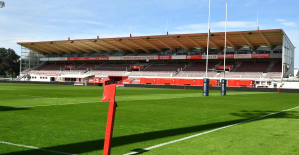In times when the circulation of large newspapers is falling dramatically, the public opinion market is clearly shifting towards the Internet. Nevertheless, the effects of Friedrich Koenig's press from 1814 can still be felt: The inventor and entrepreneur gave the London Times a decisive advantage over the competition with his high-speed cylinder press - at 800 sheets per hour, his machine exceeded the output hand-operated printers more than doubled.
The dissemination of information (albeit disinformation) entered a whole new phase, because The Times was able to get its reports to more people much faster than its competitors. Surprisingly, the innovation did not go back to a Brit: Koenig was born in Eisleben in 1774. As a child of humble farmers, the above-average talent of the young Friedrich became apparent so quickly that, in addition to attending elementary school, he was soon allowed to attend private lessons from a pastor in Eisleben.
He was also allowed to attend grammar school, and when he left he was certified as having particularly good knowledge of mechanics and mathematics. Since he could not afford to study, he began an apprenticeship as a printer at a well-known company, completing his apprenticeship after just four and a half years instead of the planned five. Together with a childhood friend, he dreamed of opening a bookshop with an attached printing shop in Eisleben.
So Koenig set about constructing his first press, but the attempt was not convincing. Crucial parts were made of wood, because quality metal was extremely difficult to obtain in the structurally weak German Reich. That is why the so-called Suhl press of 1803 did not catch on. But not only Koenig knew that Great Britain was a kind of promised land when it came to real technical innovations. So he plucked up courage and moved to London in 1806.
There, the following year, he signed a contract with the print shop owner Thomas Bensley for the use of his inventions. Koenig met the technician Andreas Friedrich Bauer (1783–1860) in London – a brother in spirit, he came from Stuttgart and had been in the city since 1805. Bensley's capital and Bauer's knowledge proved to be a great boon: Koenig was finally able to build his Suhl press from the materials its concept deserved.
In 1811 Koenig received the patent for the high-speed cylinder press, which revolutionized book printing. The designer replaced the previous crucible as a counter-pressure element with a pressure cylinder divided into three fields covered with thin felt, on which the paper was held during the printing process, initially with the help of frames and, in later versions, with straps. This significantly increased the possible printing speed.
In London, of course, the news about the miraculous device didn't just get around in the bookshops. Newspaper publishers in particular had to be able to have as much paper as possible filled with letters as quickly as possible so that more people had access to their stories.
Koenig had reached his goal: on the night of November 28th, 1814, the London newspaper "The Times" was the first daily newspaper in the world to be produced with a steam-powered version of this high-speed cylinder printing press. Your publisher John Walter the Younger was the quickest to recognize the potential of the development and immediately bought this innovation from the German; he even personally wrote an editorial about it. Today, it still draws on the lead that the “Times” built up thanks to this progress – albeit less in terms of journalism than in economic terms.
In the years that followed, the German designer acquired various other patents. However, he fell out with his local financiers: They wanted to use the patented high-speed presses exclusively in their own print shops, while Koenig was interested in the industrial production of his devices in large numbers. Because the technical innovation itself was more important to him than the lead of individual newspaper publishers. So he was drawn back home: in 1817 he returned to the continent, to Bavaria, and founded the Koenig machine works with Friedrich Andreas Bauer in a former monastery west of Würzburg
His inventive talent was not limited to printing machines: in 1828, Koenig set up the first paper mill in the Kingdom of Bavaria in the Münsterschwarzbach monastery mill, about 25 kilometers east of Würzburg. But heart trouble soon struck the man who had given England such a great head start in the news business; In 1833 he died in Oberzell. His widow Fanny (1808-1882) continued the business together with Friedrich Andreas Bauer. Koenig's sons joined the family business, which continued to flourish thanks to their inventions. A whole entrepreneurial dynasty emerged from a great pioneering achievement.
You can also find "World History" on Facebook. We are happy about a like.

 United States: divided on the question of presidential immunity, the Supreme Court offers respite to Trump
United States: divided on the question of presidential immunity, the Supreme Court offers respite to Trump Maurizio Molinari: “the Scurati affair, a European injury”
Maurizio Molinari: “the Scurati affair, a European injury” Hamas-Israel war: US begins construction of pier in Gaza
Hamas-Israel war: US begins construction of pier in Gaza Israel prepares to attack Rafah
Israel prepares to attack Rafah Spain is the country in the European Union with the most overqualified workers for their jobs
Spain is the country in the European Union with the most overqualified workers for their jobs Parvovirus alert, the “fifth disease” of children which has already caused the death of five babies in 2024
Parvovirus alert, the “fifth disease” of children which has already caused the death of five babies in 2024 Colorectal cancer: what to watch out for in those under 50
Colorectal cancer: what to watch out for in those under 50 H5N1 virus: traces detected in pasteurized milk in the United States
H5N1 virus: traces detected in pasteurized milk in the United States Private clinics announce a strike with “total suspension” of their activities, including emergencies, from June 3 to 5
Private clinics announce a strike with “total suspension” of their activities, including emergencies, from June 3 to 5 The Lagardère group wants to accentuate “synergies” with Vivendi, its new owner
The Lagardère group wants to accentuate “synergies” with Vivendi, its new owner The iconic tennis video game “Top Spin” returns after 13 years of absence
The iconic tennis video game “Top Spin” returns after 13 years of absence Three Stellantis automobile factories shut down due to supplier strike
Three Stellantis automobile factories shut down due to supplier strike A pre-Roman necropolis discovered in Italy during archaeological excavations
A pre-Roman necropolis discovered in Italy during archaeological excavations Searches in Guadeloupe for an investigation into the memorial dedicated to the history of slavery
Searches in Guadeloupe for an investigation into the memorial dedicated to the history of slavery Aya Nakamura in Olympic form a few hours before the Flames ceremony
Aya Nakamura in Olympic form a few hours before the Flames ceremony Psychiatrist Raphaël Gaillard elected to the French Academy
Psychiatrist Raphaël Gaillard elected to the French Academy Skoda Kodiaq 2024: a 'beast' plug-in hybrid SUV
Skoda Kodiaq 2024: a 'beast' plug-in hybrid SUV Tesla launches a new Model Y with 600 km of autonomy at a "more accessible price"
Tesla launches a new Model Y with 600 km of autonomy at a "more accessible price" The 10 best-selling cars in March 2024 in Spain: sales fall due to Easter
The 10 best-selling cars in March 2024 in Spain: sales fall due to Easter A private jet company buys more than 100 flying cars
A private jet company buys more than 100 flying cars This is how housing prices have changed in Spain in the last decade
This is how housing prices have changed in Spain in the last decade The home mortgage firm drops 10% in January and interest soars to 3.46%
The home mortgage firm drops 10% in January and interest soars to 3.46% The jewel of the Rocío de Nagüeles urbanization: a dream villa in Marbella
The jewel of the Rocío de Nagüeles urbanization: a dream villa in Marbella Rental prices grow by 7.3% in February: where does it go up and where does it go down?
Rental prices grow by 7.3% in February: where does it go up and where does it go down? Even on a mission for NATO, the Charles-de-Gaulle remains under French control, Lecornu responds to Mélenchon
Even on a mission for NATO, the Charles-de-Gaulle remains under French control, Lecornu responds to Mélenchon “Deadly Europe”, “economic decline”, immigration… What to remember from Emmanuel Macron’s speech at the Sorbonne
“Deadly Europe”, “economic decline”, immigration… What to remember from Emmanuel Macron’s speech at the Sorbonne Sale of Biogaran: The Republicans write to Emmanuel Macron
Sale of Biogaran: The Republicans write to Emmanuel Macron Europeans: “All those who claim that we don’t need Europe are liars”, criticizes Bayrou
Europeans: “All those who claim that we don’t need Europe are liars”, criticizes Bayrou These French cities that will boycott the World Cup in Qatar
These French cities that will boycott the World Cup in Qatar Archery: everything you need to know about the sport
Archery: everything you need to know about the sport Handball: “We collapsed”, regrets Nikola Karabatic after PSG-Barcelona
Handball: “We collapsed”, regrets Nikola Karabatic after PSG-Barcelona Tennis: smash, drop shot, slide... Nadal's best points for his return to Madrid (video)
Tennis: smash, drop shot, slide... Nadal's best points for his return to Madrid (video) Pro D2: Biarritz wins a significant success in Agen and takes another step towards maintaining
Pro D2: Biarritz wins a significant success in Agen and takes another step towards maintaining


















